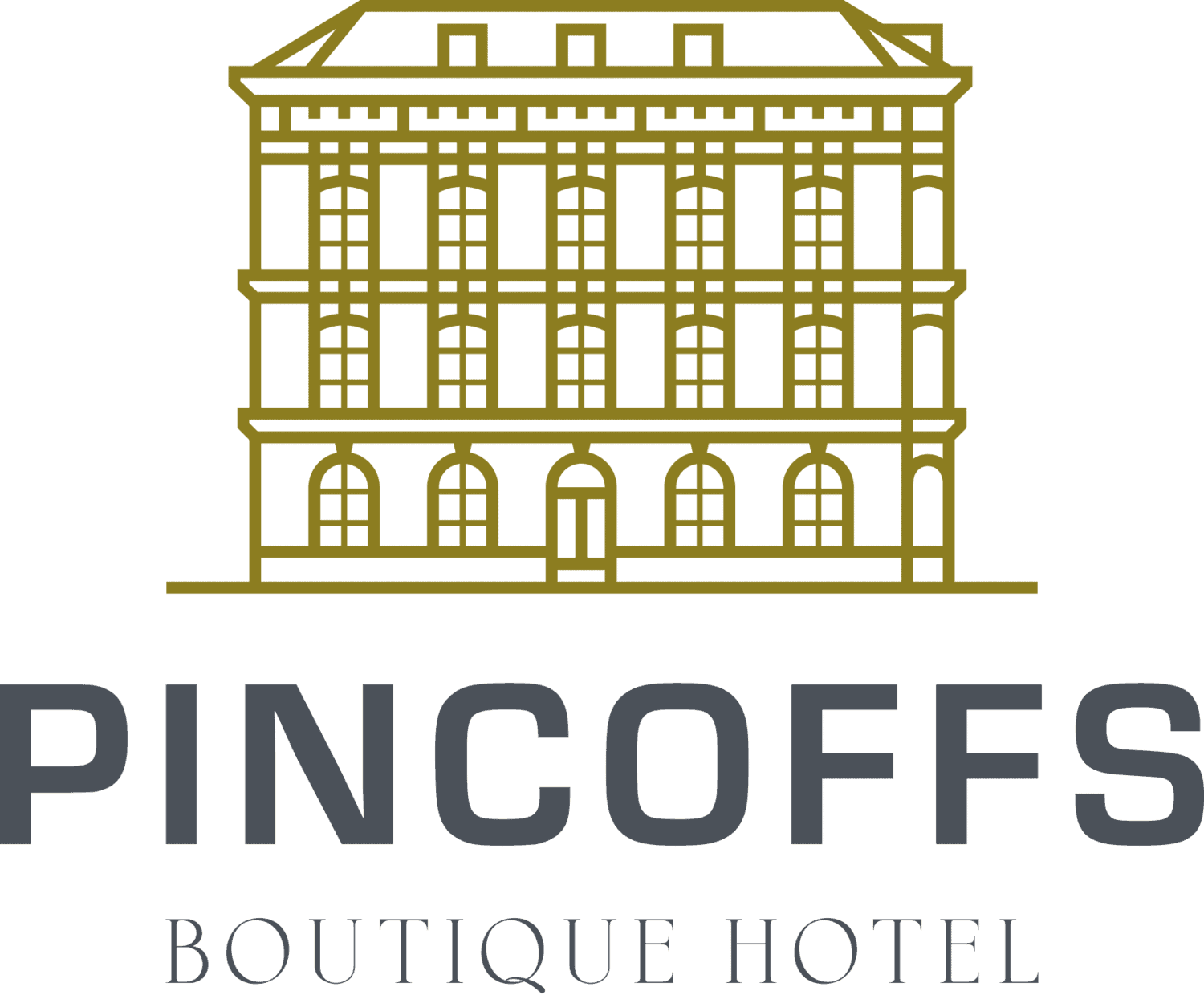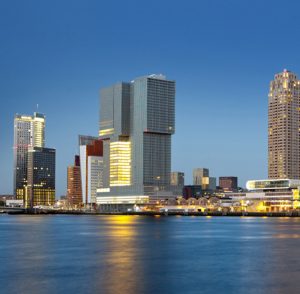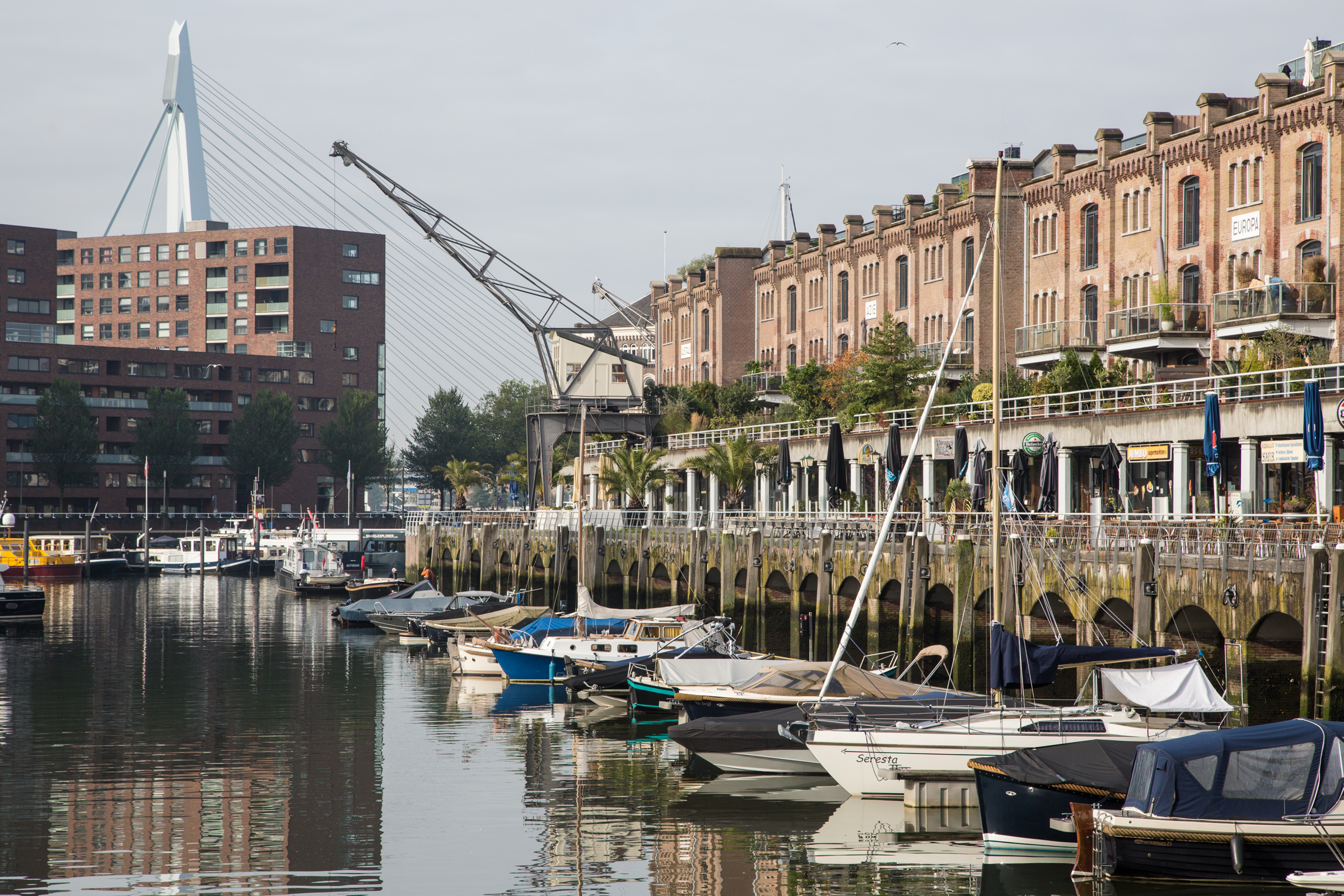Back to the website of The Pincoffs Hotel
This text is a one-to-one copy from the text The vibrant waterfront of Rotterdam, copywright by Lonely Planet:
The vibrant waterfront of Rotterdam
CATHERINE LE NEVEZ
Lonely Planet Writer
Rising along the vast Nieuwe Maas (a tributary of the Rhine), Rotterdam started life as a medieval fishing village. Its importance skyrocketed in the 17th-century Golden Age following the discovery of the maritime trade route to the East and West Indies, and in the 19th century, the Nieuwe Waterweg (New Waterway) canal created a direct link to the North Sea. Today, the port – Europe’s largest – is the lifeblood of this vibrant Dutch city and the entire waterfront is packed with attractions, from maritime museums to boat tours, cycleways and superb harbourfront dining, along with visionary new developments.
Waterborne city excursions
Water shapes Rotterdam’s cityscape and a boat trip is the ultimate way to get a sense of its maritime past, present and future. Get your sea legs on one of Spido’s fascinating 75-minute harbour tours (2½ hours in July and August that also include the port) from the pier at Leuvehoofd near Rotterdam’s iconic cable-stayed bridge, the Erasmusbrug (dubbed de Zwaan, meaning ‘The Swan’, for its graceful white curvilinear design). Alternatively, take an hour-long amphibious bus/boat ride with Splashtours, catching spectacular views of the city’s constantly changing skyline.
Maritiem Museum
In honor of the city’s indespensible seafaring tradition, Maritiem Museum Rotterdam was founded in 1874 and contains a huge collection of ocean vessel artifacts and curiosities. Exhibits include model ships (including Europe’s oldest, the Mataró, dating back more than six centuries), precious documents (notably Jan Huygen van Linschoten’s 16th-century Portuguese travel journal Itinerario) and interactive displays. You’ll also find regularly updated, engaging temporary exhibitions. It’s free to wander the quays; there are interpretative signs in English and Dutch. Also, keep an eye out for the new ‘Offshore Experience’ (www.maritiemmuseum.nl), opening later in 2016.
Rainy spring day in the harbor of Rotterdam with bicycles and vintage boats.
Cycling is an essential activity in the Netherlands. Photo by abyrvalg00 / Getty.
Get active on the waterfront
Cycling is the quintessential Dutch pastime. Here, the Nieuwe Maasparcours trail stretches for 28km in a circuit that covers the entire harbour. It’s also a fantastic spot for walking, jogging or inline skating. Pick up a map from Rotterdam Tourist Information, which has branches in the city centre at Coolsingel and at the city’s striking train hub, Rotterdam Centraal Station.
Harbourside dining
Water views unfurl from some of Rotterdam’s finest restaurants. On the ground floor of the Netherland’s largest building (the luminous glass De Rotterdam), internationally influenced restaurant HMB has ring-side seats in front of the Erasmusbrug. Views also extend from De Rotterdam’s 7th-floor cocktail bar terrace.
In a former Katendrecht waterfront warehouse, market collective Fenix Food Factory incorporates vendors and artisans selling Dutch cheese, bread and baked goods, locally grown fruit and veggies, Rotterdam-roasted coffee, craft beer and more, along with rotating food trucks. You can dine inside or out on the harbourfront terrace.
Housed in the former Royal Yacht Club is the absorbing Wereldmuseum (‘World Museum’), celebrating multiculturalism, as well as its Michelin-starred namesake restaurant, with glittering water vistas of the historic Veerhaven, where you can see incredible ships (which are often historic themselves).
Across the Veerhaven to the west, you can get a taste of the ocean at swish seafood specialist Zeezout (http://restaurantzeezout.nl/), which crafts contemporary dishes such as swordfish roulleaux with Bloody Mary dressing or yellow tail tuna with wasabi ice cream.
Meanwhile, the British pub aboard Vessel 11 brews its own ale, hosts live gigs (mainly rock) and barbecues and does a great Sunday roast.
DIY transport
Water taxis criss-cross the harbour between a network of some 50 docks, and offer an adrenaline-filled ride (boats are small and low to the water, meaning you’ll feel every bump and occasional splash). For an ultra-relaxing punt around the harbour, you can bob about in a HotTug (http://verhuur.hottug.nl/locaties_en.htm) — an ingenious, Rotterdam-designed hot tub boat while you soak in its steaming wood-fire-heated water (especially atmospheric on a chilly day). Rent it from the fire-engine-red, 1951-built lighthouse vessel (with a working gas light and fog horn) that houses gastropub Vessel 11.
Harbour festivities
If you’re in Rotterdam in early September, don’t miss the Wereldhavendagen (World Port Days), when you can tour normally off-limits industrial areas, see nautical displays and catch sea shanties. A highlight is the spin-off de Nacht van de Kaap (‘Night of the Cape’), when festival-goers don retro get-ups such as sailor and pirate outfits in Katendrecht, Rotterdam’s former red-light quarter.
Sleeping by (and on) the water
Stunning places for a history-steeped, waterside stay include Pincoffs, a boutique former customs house dating from 1879 with romantic rooms fitted out with up-to-the-minute tech, with a water-taxi stop at the door. Snazzy design hotel Mainport also has its own water-taxi stop and state-of-the-art rooms with themes that recall far-flung locations and Rotterdam’s role as a port and a luxuriant 8th-floor spa.
(Note from the hotel: Please use the discount code discount1879 if you book at the official website of The Pincoffs Hotel)
Stroom, in a converted power station near the charmingly preserved neighbourhood of Delfshaven (once the official seaport for the city of Delft, and the departure point for the Pilgrims en route to the New World), also has up-to-the-minute rooms.
If you’re looking for sweeping views, it’s even possible to stay in one of two suites up inside the landmark 185m-high Euromast observation tower that provides 360-degree panoramas.
And to stay on the water, book into nostalgic transatlantic ocean liner SS Rotterdam, which was built in the city in the late 1950s. Now permanently moored in Katendrecht, its 576 original cabins have been converted to 254 ’50s-style hotel rooms. Ship tours – often lead by former employees of the vessel in its star-studded oceanfaring days (listen for stories about guests like Frank Sinatra, Ella Fitzgerald and the Dutch Royal Family) are available for guests and non-guests.
The waterfront’s most iconic hotel, however, is the art nouveau Hotel New York, the Holland-America passenger-ship line’s former HQ, with a water-taxi service, original fittings and timber-panelled suites in the old boardrooms. Even if you’re not staying here, stopping by for a meal or a drink is a quintessential Rotterdam experience.
Back to the website of The Pincoffs Hotel
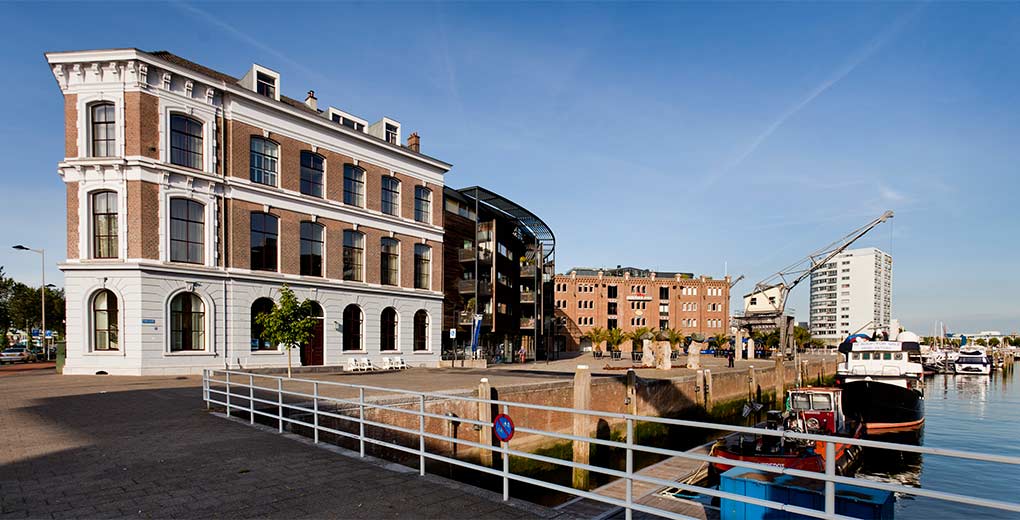
The Pincoffs Hotel in Rotterdam – riverfront and next to the historic Entrepot Harbor, now a city Marina. Foto Fred Ernst
Futuristic developments
Rotterdam’s port, like its adventurous architecture, continues to evolve. Currently covering 12,500 hectares (a total length of 40km) to the west of the modern-day city centre, it serves 30,000 ocean-going vessels, 110,000 inland vessels annually and is staffed by a workforce of 180,000 people. But it’s expanding dramatically with the ongoing construction of Maasvlakte 2 (www.maasvlakte2.com), a 2000-hectare, deep water-access artificial island that will double the port’s capacity.
Maasvlakte 2’s visitor centre FutureLand, runs bus and boat tours (in Dutch, with English information sheets available), allowing you to see the port under construction and the massive cranes loading containers in action. There’s a bird’s-eye-view cafe here opening to a terrace.
In July and August Spido (www.spido.nl) organises additional 2½-hour extended tours that include the port.
Hook of Holland (Hoek van Holland) beach in South Holland, Netherlands
Hoek van Holland. Photo by Alexander Spatari / Getty.
PUBLISHED AUGUST 2016
Experiencing the public art of Rotterdam
TIPS & ARTICLES
Back to the website of The Pincoffs Hotel
CATHERINE LE NEVEZ
Lonely Planet Writer
The Dutch port city of Rotterdam is an open-air gallery of modern and contemporary art, set against a backdrop of some of the most adventurous architecture in Europe. More than 1000 artworks and monuments from modern and contemporary masters that fill its public spaces along with sculptures by under-the-radar artists, vivid street-art murals, pioneering urban landscaping and wildly innovative installations.
Rotterdam’s role as a creative hub rose phoenix-like from the ashes of its WWII devastation, which gave architects and artists a blank canvas that continues to evolve today and whose works inspired hope and courage during the city’s massive reconstruction. Thanks to Rotterdam’s pedestrian-friendly size, a tour of its public art is one of the great ways to explore this uniquely modern European urban landscape.
Blockbuster sculptures
A powerful reminder of the horrors of WWII is Ossip Zadkine’s masterwork, The Destroyed City (1951-1953). Rising 6m high, it depicts a man falling back against a tree and throwing his arms skyward in despair; the gap in his torso represents the hole left in the heart of the city following the 1940 bombardment. The sculpture stands near Blaak, near Rotterdam’s monumental, Markthal Rotterdam, a futuristic residential building which opened in 2014 and incorporates an incredible arched muralled ceiling over its enormous market hall. At an unbelievable 11,000 square meters in size, some have pointed to this mural as the largest artwork in the Netherlands.
Other renowned artists you’ll encounter include Golden Age sculptor and architect Hendrick de Keyser, whose larger-than-life-size sculpture Erasmus (1622) commands the Grotekerkplein, a public square in front of Frote of Sint-Laurenskerk (St Lawrence Church), the only medieval building in Rotterdam to survive WWII bombing. The statue immortalises the humanist, theologian and thinker Desiderius Erasmus Roterodamus (the city’s signature white cable-stayed bridge, the Erasmusbrug, is also named after him).
Pablo Picasso was the mastermind behind Sylvette (1970), which he designed in Cubist style before it was rendered in sandblasted concrete and black stones by his friend and collaborator, Norwegian artist Carl Nesjar. Set on Westersingel near the city’s top art museum, Museum Boijmans Van Beuningen, it portrays Picasso’s model and muse Sylvette David, whom Picasso met in France in 1954 when she was 19 (David herself later also became an artist).
Auguste Rodin’s L’homme qui marche (The Walking Man; 1905), opposite Westersingel 45, displays incredible anatomical detail as it illustrates a headless man in mid-stride.
Appearing to protrude from a brick wall, Henry Moore’s Wall Relief No. 1 (1954), with geometric patterns and Moore’s classic abstract figures, is made up of 16,000 hand-carved bricks. It’s just southwest of the main entrance of the striking, stainless-steel-clad Rotterdam Centraal train station on Weena.
Perhaps the most controversial big-hitter is Paul McCarthy’s outsized Santa Claus (2001), on Eendrachtsplein. The bulbous gnome-like figure holds aloft what appears to be a Christmas tree but is actually a sex toy – a fact that stirred up huge debate among politicians and residents, reigniting the timeless question of what constitutes art.
Understated treasures
Lesser-known works are everywhere you look. Standouts include the highly symbolic sculpture Cascade (2010) by Atelier van Lieshout: a polyester-constructed stack of 18 full-size oil drums that drip with human figures. The soaring column dominates Churchillplein opposite the Maritiem Museum (Maritime Museum).
Intense yellows, oranges, greens, blues, pinks, purples and more eye-popping colours are used in Henk Visch’s Marathonbeeld (2001), with the artist’s aim being to brighten even the rainiest day. The angular structure, which recalls a giant, deconstructed Rubik’s cube, stands at Willemsplein in the shadow of the Erasmusbrug.
Another riot of colour, Karel Appel’s 1970 work, zonder titel (untitled), features a wavy concrete framework filled with vivid, mostly primary-coloured glass. It’s situated at the Hofplein Theater, at Benthemplein.
Urban landscaping
Art in Rotterdam is not only aesthetic but often functional too. In front of Appel’s work by the Hofplein Theater is the Waterplein, Benthemplein – a geometric, amphitheatre-style water plaza. Sections painted in blues and greens show where excess rainwater is collected, as part of the commitment to further climate-proof the below-sea level city by 2035.
One of the most intriguing installations in Rotterdam right now is the Bobbing Forest (www.dobberendbos.nl; 2016), built by local art collective Mothership founder Jeroen Everaert and based on work by artist Jorge Bakker. This installation is found in 19th-century port Rijnhaven, itself a ‘test site’ for new urban design initiatives where new high rises dominate. The ‘forest’ comprises 20 elm trees floating in decommissioned ocean buoys (including one on the shoreline that you can view up close), and is meant to question the relationship between urbanites and the natural environment. It’s expected to remain here in the harbour until at least 2021.
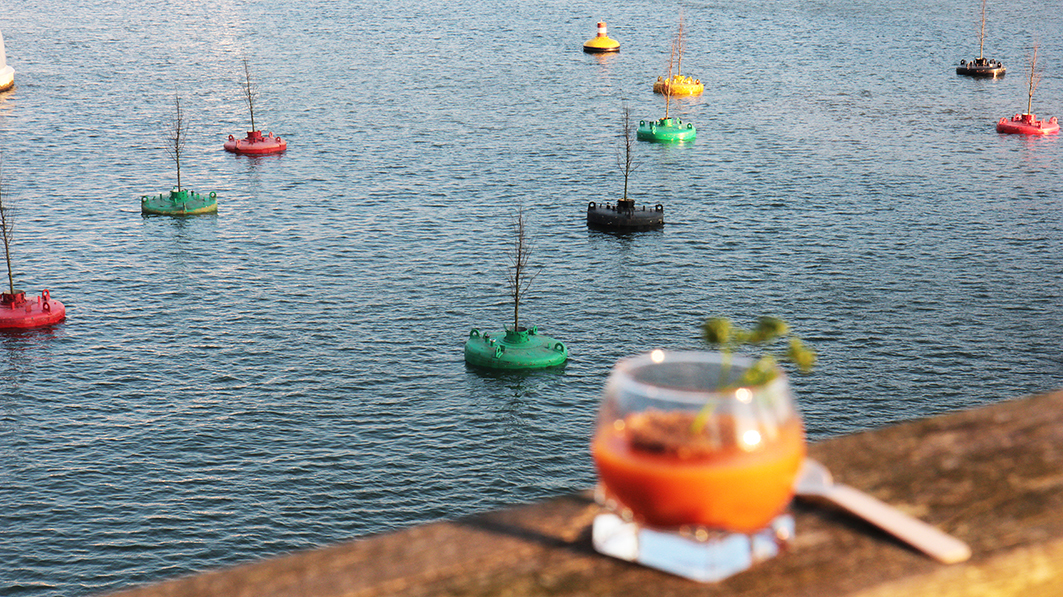
Bobbing Forest in the Rotterdam Rijnhaven, near the Pincoffs Hotel. The Pincoffs Hotel is a proud sponsor of this project made by Mothership. Foto EvdM
Artistic events
A brilliant place to find out about temporary public art exhibitions, installations and other events to check out during your visit is the Witte de With Centre for Contemporary Art – one of several contemporary culture institutions on and around Witte de Withstraat, the city’s most creative street. Several institutions on this street (including TENT, Worm and the gallery MAMA) are known as the ‘Kunstblock Rotterdam’ (Arts Block Rotterdam; http://kunstblock.nl). These boundary-pushing spaces encapsulate the diversity of Rotterdam’s art scene, both outdoors and in, across all genres. The first Friday of every month is Art Evening, when the venues are free to visit between 6pm and 9pm, and free one-hour introductory tours set out from 7pm.
Look out too for ‘Z-Files’ (www.cbkrotterdam.nl), a program of regular talks, tours and events that showcase public art in the city and spotlight new and upcoming projects.
Street art scene
More and more colour is splashed across the city as artists create dazzling street murals. This scene is much more fluid than the city’s sculptures, with works regularly being renewed. A reliable spot to catch rotating murals is around Station Hofplein (the former station of the disused Hofpleinlijn railway, with cultural and creative spaces in its viaduct arches). You’ll also find street art along with the wooden Luchtsingel (‘air canal’) footbridge over the train tracks, which links Station Hofplein with the repurposed office block-turned-studio hub, the Schieblock.
For insight into Rotterdam’s vibrant street art, join the Graffiti & Bar Tour. These two-hour guided walking tours are run by hip backpacker hostel Ani & Haakien, and depart at 9pm on Friday nights from the hostel, just near Rotterdam Centraal train station. Non-hostel guests are welcome and no advance reservations are necessary. Payment is by donation.
Alternatively, the excellent, inexpensive app, The Rotterdam Street Art Tour (RSAR; http://rewriters010.nl) maps out a 7km-long self-guided trail that takes in murals especially created by local artists for the route.
Public art routes & resources
Rotterdam is an immensely walkable city, and there are a number of resources to help you make the most of your time exploring the city’s rich public art. Apps that provide curated, self-guided tour routes through Rotterdam’s vast collection of public art include the free Rotterdam Routes (http://rotterdamroutes.nl), with various walking and cycling trails such as an Art & Poetry route.
Finger-on-the-pulse local outfit UrbanGuides has Art & Architecture walking and cycling tour route maps, as well as route maps of the city’s most artistic neighbourhoods; it also runs fascinating guided tours on foot and by bike.
PUBLISHED JULY 2016
The vibrant waterfront of Rotterdam & Experiencing the public art of Rotterdam
